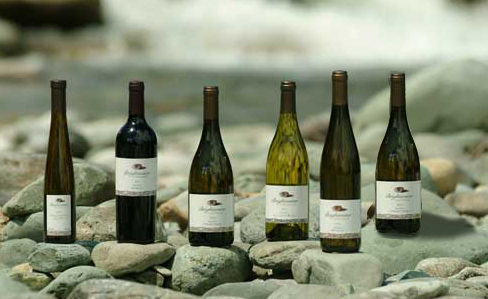
New Zealand wine is a wine unlike any other due to its climate, soil, and water. New Zealand vineyards are grown in a maritime climate. The sea controls the climate creating cooler winters and hotter summers; this also means that there are warmer clearer days and cooler nights from the sea breeze, creating slow ripening environments which create unique tastes. Also most of New Zealand’s vineyards are located in free draining alluvial valleys. These deposits make up most of New Zealand’s mountains. These deposits create the different quality characteristics in the wine, and these are often mentioned on the wine label.
New Zealand wines production started as late as 1970, as before this there were hardly any grapes planted on the island. New Zealand now has ten main wine growing regions. These are scatted throughout New Zealand and each has their own variety in climate and environment. The difference in the environment and climate means that the different types of the same wine can be harvested throughout a variation of 8 weeks throughout the country. The main winery regions are Northland, Gisborne, Hawkes Bay, Auckland, Walkato, Wairarapa, Marlborough, Nelson, Canterbury/Waipara Valley, and Central Otago.
Northland was the first place in New Zealand where vines were planted in 1820. However it is still New Zealand’s smallest wine producing area, as winemaking nearly died out here until a bigger interest within winemaking which has developed in the recent years. Northland is now expanding rapidly with three grape growing areas Kaitaia, around the bay of the islands, and near Northlands biggest city Whangarei. The high popularity for the regions wines Cabernet Sauvignon, Merlot, and Chardonnay, come from the fact it offers New Zealand’s warmest ripening conditions, therefore these are the most planted grapes within this area. Vineyards within Northland are mainly planted upon flat and slight slowing topography. The soils within Northland vary from shallow clay soils over sandy-clay soils.
Gisborne offers vineries the world’s most easterly vineyard planting point. These vineyards are the first to see the sun each morning and this region receives a high amount of sunshine hours accompanied by shelter from New Zealand’s range of mountains to the west. Chardonnay makes up about half of the regions vineyards and Gisborne has been renamed the Chardonnay capital of the world by its wine makers. The vineyards here are mainly planted on flat land and the soils include alluvial loams over sandy and volcanic subsoil.
Hawkes Bay is the second largest vinery region in New Zealand. This region offers a large range of soil types from fertile silty loams to free draining sand, and stones to heavy silts. Ripening dates within this area for one wine can vary by 4 weeks, from the hot soils of the lower areas, to a higher cooler altitude of central Hawkes Bay. Chardonnay again here is the most planted grape, but Hawkes Bays lengthy sunshine hours mean that later ripening red grapes such as Merlot, Cabernet Sauvignon, and Syrah, are also popular here.
Auckland is New Zealand’s more traditional winemaking area. Here Cabernet Sauvignon, Merlot, and Chardonnay are the most planted grapes. The Auckland regions soils are mainly shallow clays over hard silty-clay subsoil.
Waikato south of Auckland offers smaller vineyards that are scattered among farmland. Wine production here is mainly of Chardonnay, Sauvignon Blanc, and Cabernet Sauvignon. The soils here are of heavy loams over clay subsoil. The climate here is moderately warm, as Waikato is situated highly north within New Zealand.
Pinot Noir is Wairarapa‘s most planted grape. This is the regions most acclaimed grape. The success of this grape comes from the development, the quality, and the focus which the regions wine makers have put in. Although this region is small in terms of wine production, the quality of the wines produced keeps New Zealand’s wine quality reputation very high.
In the hot days, and the cooler night climate and free-draining alluvial loams over gravely subsoils provides Marlborough’s vineyards, which produce great fruit flavours. The world has been exposed to its brand new style and taste of Sauvignon Blanc. Chardonnay, Pinot Noir, and Riesling are also widely planted within this region. Marlborough wines have earned a great reputation from Sauvignon Blanc, and have also become New Zealand’s largest and most known wine growing region. Sparkling wines, and a wide range of white and red wine is also produced here.
Nelsons vineyards consist of the grape varieties which are best grown in cooler temperatures. Situated on the west cost the mountains, the west to this region provides a rain shadow effect, and also the coastline helps moderate the temperatures. Here Chardonnay, Sauvignon Blanc, Riesling and Pinot Noir are mainly produced in this area.
In Canterbury there are two main areas for the wine production. These are around the city of Christchurch, and the newer development of Waipara. Chardonnay, Pinot Noir, Riesling, and Sauvignon Blanc make up most of the vineyards, and Canterbury is NZs fourth largest wine region.
Central Otago is the world’s most southerly wine growing region. It has a continental climate with more extreme seasons than any of New Zealand’s regions. The soils have heavy deposits of mica minerals and schists in silt loams. Pinot Noir, Chardonnay, Sauvignon Blanc and Riesling are mainly grown here. Central Otago is a beautiful region, with pure fresh air, and vibrant views. The wine of Central Otago is said to reflect the stunning area.
By Andrew Roberts

Hampers
New zealand wines look great . Thanks for making me explore the unique characteristics of wine and sharing the largest inventories of wine in Newzealand.
Grafiker
I love New Zealand wine. It have so many different notes. Thanks for the great post!